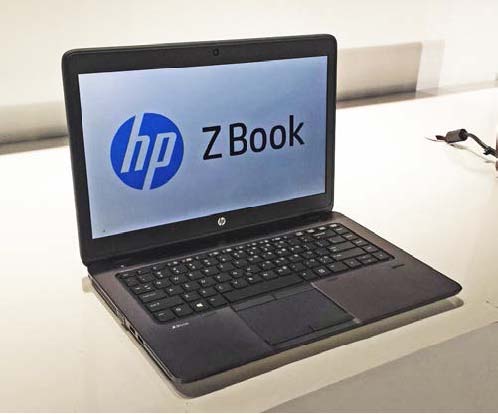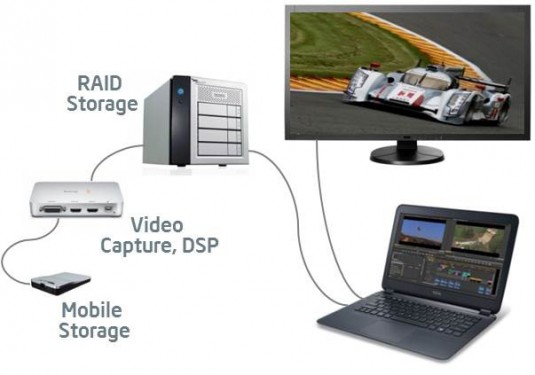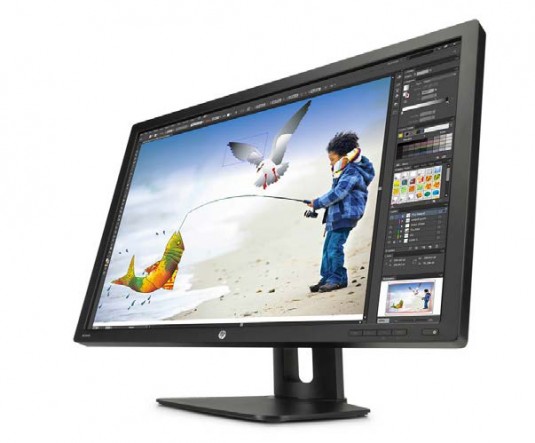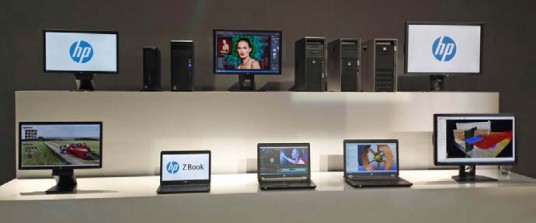A refresh for the deskside, a svelte new line of notebooks, new high-end monitors, and Thunderbolt I/O. HP intends to stay on top in workstations.
By Alex Herrera
HP’s workstation division from Fort Collins, Colorado recently showed off their new lineup at a gala event in New York. These guys have to be one of the business unit darlings at HP. At the very least, it’s got to be the darling of HP’s beleaguered Personal Systems Group (PSG). Because while the decline in the mainstream PC markets has been decimating revenue for consumer and corporate PCs, the workstation market is on a decidedly different trajectory. Worldwide, the industry shipped approximately 940,000 workstations in the second quarter of 2013, marking growth of 5.5% and 6.4%, sequentially and year-over-year respectively. Such positive numbers stand in stark contrast to the glum results and forecasts coming from the broader PC market, for example, Gartner, Inc.’s, report of a 10.9% decline in PC shipments in the same quarter. With HP the market leader in volume in one of the few growing, high-margin computing segments—if not the only one—the company’s team in Fort Collins is responsible for one of the few bright spots on the PSG’s P&L.
Which leads us to the event in New York. HP’s impressive track record in workstation innovation had set expectations high for this unveiling. This company introduced the first small form factor workstation, Z200 SFF, in 2010. In 2012 they reimagined the all-in-one for workstations and introduced the Z1. How would the company follow up on its previous industry firsts? Well, with another workstation first, of course, along with a revamped deskside line and a full range of professional-caliber displays.
ZBook mobile workstations: evolution and re-invention
If you’re keeping track, you’ll remember Intel launched its latest generation CPU, Haswell, in June 2013, and HP followed in August with a refresh of its entry-class Z200 series, launching the Z230. We hadn’t seen the new mobile models tapping Haswell … until now. In New York, HP unveiled a trio of replacements for its previous-generation, Ivy Bridge–based mobile workstation models, the EliteBook 8770w, 8570w, and 8470w.
HP took the opportunity of a Haswell refresh to do what we figured it would eventually do: unify the mobile models under the same “Z” brand umbrella that’s long identified its market-leading deskside models. Introducing the ZBook 15 and ZBook 17.
Filling the familiar product slots by screen sizes 17.3 inches and 15.6 inches, the ZBook 17 and 15 get higher-end Haswell mobile-slanted Core i7 and i5 quad- and dual-core CPUs. The displays appear unchanged from their respective predecessors, and both support 1920 x 1080 resolutions with a 10-bit per channel DreamColor option for the ultimate in visual fidelity. GPU options on both have been upgraded to include new Kepler-generation offerings from Nvidia, along with Optimus technology, to allow users to exploit Haswell’s lower-power on-chip GPU (HD Graphics 4600) when performance demands are low.

The most noteworthy enhancement to this round of mobile models, however, has nothing to do with CPUs and GPUs, but rather I/O. For the first time in a workstation, HP is making available Intel/Apple’s Thunderbolt I/O.
Now, the ZBook 15 and 17 are perfectly sensible products to release on the heels of Haswell. But where’s that re-invention HP promised? While they are worthy upgrades, the ZBook 15 and 17 are relatively conventional in form and function. And where’s the third member of the mobile trio? The one to fit that sub-15-inch slot the company had always supported? The answers to both are one and the same: the Z Book 14, a new model that shares the new Z branding, but whose shape and style is decidedly unconventional.

Ultraworkstation
It seems like a long time since Intel kicked off its Ultrabook concept and campaign. Envisioned as a MacBook Air killer—or at least as a similar ultra-thin option for the Wintel crowd—the Ultrabook concept didn’t hit the heights Intel had hoped. It ran up against two notable headwinds: high prices and the tablet onslaught.
However, for those who need a conventional, keyboard-enabled mobile x86 machine, the thin-and-light, touch-enabled Ultrabook certainly has appeal, and workstation professionals are potentially a good fit for an Ultrabook-type machine. The only problem to Ultrabook acceptance among workstation pros is that there’s never been one that was equipped for workstation apps, with lack of ISV certification and professional-caliber GPUs being the primary deficiencies. But no longer.
In New York, HP unveiled the ZBook 14, the industry’s first workstation-caliber Ultrabook. The ZBook 14 combines the key features buyers have come to expect out of a mobile workstation, but comes packaged in a compact, thin-and-light, touch-enabled Ultrabook wrapper. Built around a dual-core Haswell-class CPU, a 14.0-inch screen (not quite HD at max 1600 x 900 resolution), an AMD FirePro M4100 GPU, and up to 16 GB of memory and 1.25 TB of storage, the ISV-certified ZBook 14 earns its workstation pedigree.
The ZBook is not going to be the highest-performing mobile workstation around—that’s not its goal—but it will be one of the most mobile. At 3.6 pounds and 0.83 inches thick, the ZBook 14 is positively svelte compared to its bigger ZBook 15 and ZBook 17 siblings. For those who can sacrifice a bit of performance on the road, the 10-point touch-enabled ZBook 14 will surely entice. We imagine it might have special appeal as a VDI client for those who might want to start experimenting with remote, server-based graphics (à la Nvidia Grid).
The deskside Z line gets Ivy Bridge
As anticipated, HP announced an Ivy Bridge-EP upgrade to its existing line of deskside Z workstations. The flagship trio Z420, Z620, and Z820 hadn’t seen a refresh since Sandy Bridge-EP back in the spring of 2012, so the eventual move to Ivy Bridge was a foregone conclusion. Ivy Bridge is primarily a shrink of Sandy Bridge to 22 nm, with some relatively modest feature enhancements tossed in. The “-EP” version taps the same basic microarchitecture as the first Ivy Bridge CPU SKUs released back in 2012, but dials up capabilities to support dual-socket workstations and servers.
Why Thunderbolt?
Taking on Ivy Bridge-EP was completely expected. The upgrade has been in the cards ever since Ivy Intel launched its single-socket SKUs (Core and Xeon E3), saving dual-socket Xeon E5–class for later. But where Ivy Bridge-EP was no surprise, the other major enhancement to HP’s deskside Z line was Thunderbolt I/O. To go with the new Thunderbolt support on its mobile models, HP announced that it would begin providing an option for Thunderbolt 2 I/O via an add-in PCI Express card (availability expected in January).
Thunderbolt 2 features an impressive 20 Gb/second of serial bandwidth, or as HP puts it, essentially “exports PCI Express” performance outside the box. That’s a big jump over USB 2.0 or even USB 3.0, the latter of which at 5.0 Gb/ second can only achieve a quarter of what Thunderbolt can do (though really a bit more than that, when one considers utilized bandwidth). And it’s daisy-chainable (to six devices), something USB can’t match.

So with those advantages, why isn’t Thunderbolt more widely used? Thunderbolt hasn’t had the easiest time catching on, as scant few applications or devices have materialized to give Thunderbolt any kind of broad-based demand. Because while 4X is a nice bump in throughput, it turns out USB 3.0’s 5 Gb/ second is pretty damn fast for most I/O needs. There aren’t many applications that really had to have more, or at least needed it enough to push an unproven, proprietary standard. Ultimately, if it weren’t for Apple (with different goals, for example, uniqueness), Thunderbolt may not have made it at all.
But Thunderbolt does fill a need; it turns out the workstation space is where we’re seeing most of the demand for higher-speed I/O. Take a look at the current showcase devices for Thunderbolt and you’ll see a lot of storage devices. That’s why it makes sense the first notable appearance of Thunderbolt on a Wintel-class machine came on a workstation.
Many professionals’ workflows require storage and retrieval of multiple Terabytes of data. And while a consumer may not care about what Thunderbolt could do to speed the download of a 5 MB MP3 file, oil/gas field interpreters and Hollywood-caliber post-production visual effects directors certainly do. Consider one scene effects director, Mark Russell—on stage at HP’s event—had to manage in the upcoming Martin Scorsese picture, The Wolf of Wall Street. A short fly-in to a Hampton Beach site (to be used as the backdrop to a virtual set) recorded at 4K resolution RAW consumed so much data that simply transferring the data became the critical path in the field, killing productivity.
But he won’t have the same problem in his next feature, with Thunderbolt-enabled Z Book 15s or 17s on location or deskside Zs back at the office. Thunderbolt 2’s 20 Gbps rate can simultaneously transfer and display the increasingly popular 4K video formats.
Z displays
HP has for some time wisely coupled premium monitors with its workstations, though the tie-in has not been totally consistent or formally branded. However, that’s now all changed with the introduction of five new IPS displays, the first three of which were unveiled at Siggraph 2013 in conjunction with the Z230 workstation. This time, the new displays come co-branded with the familiar “Z” prefix.

HP is not simply rolling out plain vanilla monitors and slapping a workstation brand on them. These three new displays—the Z22i (22-inch), Z23i (23- inch), and Z24i (24-inch)—offer premium features that better serve the higher demands of professional users, for example, 250 cd/m2 brightness and 1000:1 contrast (5M:1 dynamic contrast).
But the key differentiation is the IPS (in-plane switching) technology that can deliver a wider viewing angle (178 degrees) with accurate color from any angle. Couple that with an ergonomic four-way adjustable stand (rotates for portrait and landscape) and 99% coverage of sRGB color space, and you’ve got products that are certain to appeal to the workstation crowd. At 1920 x 1080, the only area the initial trio of Z displays is not above-and-beyond is in resolution.
But HP remedied that situation in New York. Complementing the previously launched IPS models Z22i, Z23i, and Z24i, in New York HP announced two bigger versions of the same technology, the Z27i and Z30i. Displays of this size really demand higher resolution, and HP obliged: the Z27i can handle 2560 x 1440, and the Z30i does 2560 x 1600.
Furthermore, displays of this price have to be perfect, or close to it, when it comes to color space. Where the smaller trio of monitors hit 99% sRGB coverage, this newest pair hits 100%. And the biggest and priciest Z30i matches that with 100% Adobe RGB coverage, mandatory for high-end video and images, enticing professionals away from the Mac.
It’s an ironic concept: an old PC company like HP drawing customers away from the darling of style-tech, Apple. Yes, I know Apple’s been showing a few chinks in its armor lately. But still, it’s supposed to work the other way around, right? Bored and frustrated PC users are supposed to be shunning the Wintel platform in favor of the more fashionable and user-friendly Mac. But the reverse is happening in one segment, which, at first glance, might appear to be the least likely of users.
The Mac has for some time represented the bastion of creative professionals, notably video editors working Final Cut Pro. And, despite Cupertino’s unmistakable apathy in recent years to that community, the vast majority remained loyal to the Mac Pro and MacBook Pro. The company’s refreshes to the flagship Mac Pro got slower and less frequent, with Apple even skipping major generation upgrades (Intel’s Sandy Bridge-EP never made it to the Mac Pro). Adding insult to injury, the other half of the favored Apple solution—Final Cut Pro X—saw new versions that were heavily panned by hard-core users, described, for example, as simply “unusable” for professional use.
It’s not hard to understand, as big deskside clients hardly represent the type of products Apple’s into these days. And it opened the door for workstation OEMs like HP to go after a very healthy new pool of prospective customers. How big? Well, Apple at one time was shipping about as many Mac Pros as Dell or HP was shipping workstations.
Now, we’re aware of the splash Apple made with the cylindrical Mac Pro re-design in June. But it’s not shipping for a while yet, so it remains to be seen how much it will catch up, and even then, will it really signal a long-term re-commitment to the professional space? For a significant chunk of Apple pros, it’s too little, too late.
So it’s no wonder there was a recurring message at HP’s unveiling, delivered rather convincingly not by HP marketeers, but by creative professionals who had recently hopped off the Mac/Final Cut bandwagon, hooking up instead with HP workstations and applications like Adobe Premiere Pro.
And we’re talking some high-profile types, like that visual effects lead on Scorsese’s next picture, Mark Russell. An ex-Mac Pro devotee, he’s now using Z workstations across the board, both in the field for data collection (for modeling) and back at the studio in post. “I’m just using the Mac for email now,” he confided. We’ve heard similar sentiments from the Bandito Brothers, creators of last year’s reality-ish Act of Valor.
And if those testimonials weren’t enough, how about one from the co-founder of Apple itself? A new fan of HP after visiting the engineering crew in Fort Collins, Steve Wozniak hasn’t been shy about endorsing HP workstations over Apple gear. His company, Fusion-io, is a maker of solid-state storage acceleration cards targeting high-end video editing and post-production, cards that have recently been announced as options for the Z workstation line.
Today’s workstation market … not a bad place to be
Those who spend a lot of their time in the workstation trenches don’t need to be told that the workstation market is vibrant and likely to remain that way for the foreseeable future, regardless of the fortunes of the broader PC market.
We’ve always thought that HP Workstation’s location out on the Colorado plateau may have been its best asset. Nowhere near Wall Street nor Silicon Valley, HP’s workstation group is buffered from the influence and volatile emotions that can push the best-intentioned, best-staffed ventures astray.
Its location also has kept a highly competent, yet still impassioned, work group intact for many years—amazingly intact, considering the transient nature of the tech business. A team that’s stuck together (for the most part) targeting the same market for 30-odd years? Unheard of in Santa Clara, but that’s precisely what HP’s workstation unit has accomplished in Fort Collins. Based on its past performance, plying a marketplace that should remain viable for the long-term, we won’t be surprised to see that record extend another 30 years.






